What is Eco-art? An Overview
- sharmondavidson
- Feb 26
- 8 min read
Updated: Mar 4
25 February, 2025

An Overview of Eco-art
In my last post, I touched on my own interpertation of eco-art, and why I take the approach I do, focusing on the interconnectedness of everything. But there is much confusion about exactly what it is, and as many different interpretations of the genre as there are 'eco-artists'. The first thing to understand is that there is no official or set definition for the term 'eco-art', or for the sometimes confused or interchangable terms 'environmental art', 'nature art', or 'land art.' So in this post, I'll attempt to bring some clarity to the topic by givng you an overview of eco-art as I understand it.
"Eco Art or ecological art is an environmental art form which is contemporary and created to bring awareness to the situation of the environment locally and globally." (Wake Up Website - What is ECO Art?)
"Eco art is a type of art that explores ecological issues, climate change, and natural phenomena. Eco artists often use natural materials and sustainable practices to create works that activate change and draw attention to global environmental situations." (Artterra - The Complete Guide to Eco-Art and Environmental Art: Connecting Art and Nature for a Sustainable Future)

Origins in Land Art
The basic definition, two of which are cited above, seems to be agreed on: eco-art is created to bring awareness to environmental issues, and to hopefully promote change. After that, there seems to be little consensus about the rules (why do we need rules, anyway?), the precise relationship or differences between the terms, or really, anything else. Where it orginated, however, is not in dispute.
The environmental art movement came out of the Land Art movement of the 1960's and 1970's. According to the Tate Museum website, "land art or earth art is art that is made directly in the landscape, sculpting the land itself into earthworks or making structures in the landscape using natural materials such as rocks or twigs."
Undoubtedly the most famous example of Land Art is Robert Smithson's Spiral Jetty, pictured above. Entrada Institute says, "It took more than 6,650 tons of locally extracted black basalt and earth and 625 man-hours to build....Environmental art, but not necessarily environmental friendly, according to early critics." (Uncoiling the Spiral Jetty, by Frank McEntire)
While I might question whether it was wise to relocate that much earth in order to create an unnatural land form, when you consider the years that it has been there inspiring people to think about our relationship to the land, it may be worth it.

"Twelve large blocks of ice cast off from the Greenland ice sheet are harvested from a fjord outside Nuuk and presented in a clock formation in a prominent public place. The work by Olafur Eliasson and Minik Rosing raises awareness of climate change by providing a direct and tangible experience of the reality of melting arctic ice."
Types of Eco-art
Just so you know, I'm making these up. There appears to be no agreement about what types there are, or what they should be called. So, these are just the categories that make sense to me. I will include a list for further reading at the end of this post, so you can attempt to disentangle them all for yourself if you wish.
Land Art/ Environmental Art /Nature Art
Just to keep it straight in my own head, I break it down into the following categories:
Art Made by Large-Scale Earth-Moving
Already discussed above, this includes building structures, usually utilising natural materials, and/or restructuring the landscape in some way.

Art that Seeks to Help/Mend the Land
Works are meant to remediate and reclaim damaged natural environments, often restoring ecosystems in artistic ways. This includes works like Wheatfield - A
Confrontation: Battery Park Landfill by Agnes Denes, pictured above. This 2-acre
field of wheat, planted on a landfill in Manhatten, "was a symbol, a universal concept; it represented food, energy, commerce, world trade, and economics. It referred to mismanagement, waste, world hunger and ecological concerns. It called attention to our misplaced priorities." (Agnes Denes Studio website)

Above: Artist Patricia Johanson rehabilitated a polluted lake in Dallas, adding large red clay sculptures to attract people as well as wildlife.

Ephemeral Outdoor Art Made of Natural Materials
Andy Goldworthy is probably the best known environmental artist doing this type of work. Many are made of leaves, sticks, thorns, ice, stones or other materials from the site where they're constructed. These works speak to the ephemeral delicacy of natural environments; they melt, blow away, or otherwise disintegrate, and are recorded only in photographs. He has also done larger scale, more permanent earthworks, as well as indoor installations such as the piece, "Roof", which I was fortunate enough to see in the National Gallery of Art, below.

Indoor Installation Art
Made of Waste/Recycled Materials

"Through the meticulous and unquantifiable accumulation of everyday, mass-produced things she creates installations of unexpected structural coherence. These simple objects – paper plates, toothpicks, plastic cups, pins and buttons – become unrecognizable, transformed into artworks that evoke systems inherent to the natural world." (Mary Louise Schumaker)
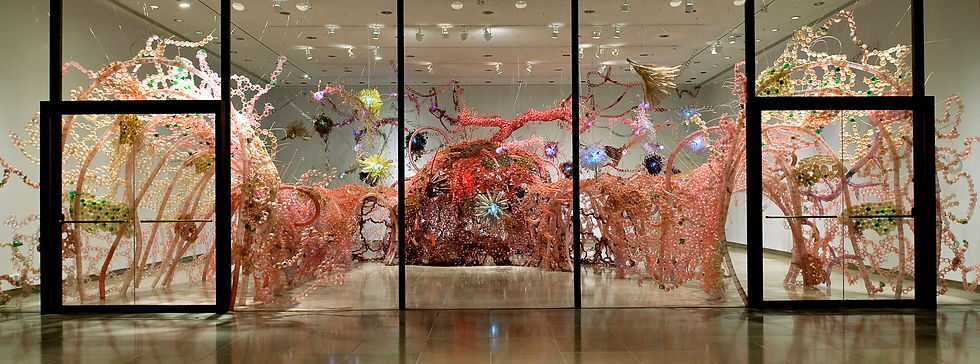
Above: Repurposing plastics from a wide range of sources, [Aurora Robson] tunes into an otherwise destructive, wasteful and abundant material resource. To build community and collective purpose, she founded Project Vortex in 2009. Project Vortex is an artist collective innovating with plastic debris...
Made of Natural Materials
Artist Per Kristian Nygård filled a gallery at Noplace in Oslo, Norway with undulating bright green hills of grass, forcing viewers to confront their relationship with nature and their concept of the separation of indoors and outdoors. Pictured below:


The Archive, Cleveland Public Library, 2023 by Rebecca Louise Law “The convenience of consumerism has made everything too easy and too fast. The lack of attention to detail and little understanding of where things come from made me want to focus the viewers' attention back to nature. Flowers are my paint and I work with space as my canvas....Over the past 16 years, I have collected over one million flowers, re-using every flower I work with. Recently this has allowed my installations to be large enough to have a complete experience of nature." ~ Rebecca Louise Law
Smaller-scale and Wall Art With a Message
Work in this category includes anything meant to raise awareness and/or inspire action around ecological issues. It also includes art made with sustainable materials, but I'm not addressing that specifically here. Neither am I going to try to organize these into sub-categories. It's just too difficult - too many ways to arrange them and too many crossovers. Now I know why no one has done this!

"There are things in the natural world that occur without us even knowing; minute actions that occur in nature that allow us to live on this planet. Things we cannot see. I choose to amplify these abstract notions of nature because we are so far removed from them..."
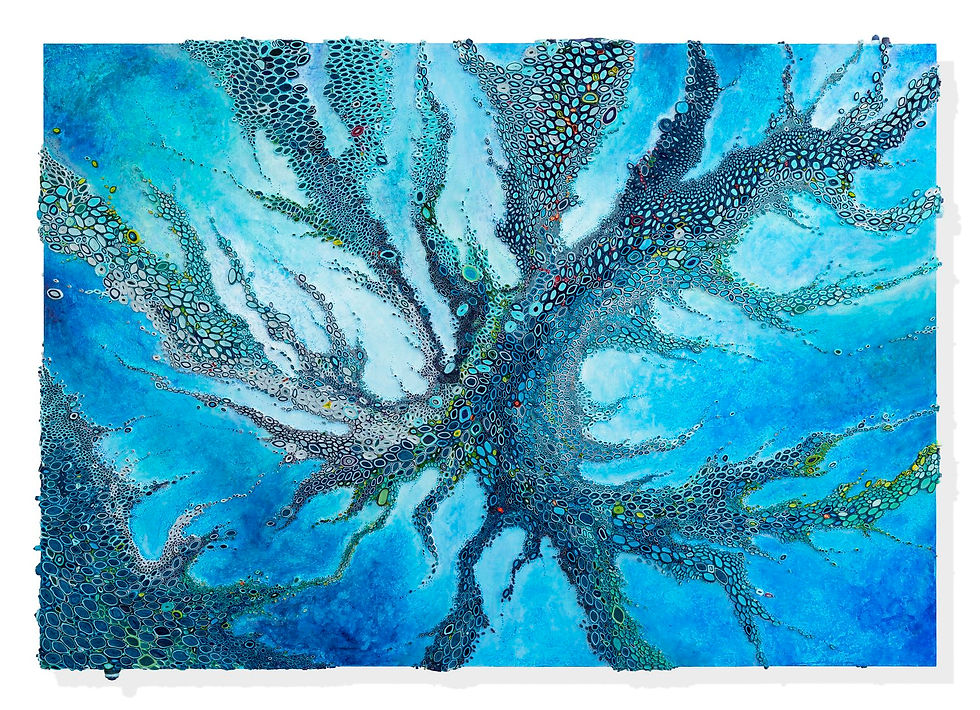
Amy Genser works with paper, paint, metal and wood to explore natural forms and organic processes.

Left, Blue Monsoon,
by Julie Maren
"Simultaneously a monsoon of rain
reflecting a blue sky and a multitude
of tear drops cascading.
This piece is a response to our
warming planet and the
fires that ravage it.
Made of clay and hope,
this is a devotional piece to
Mother Nature—a prayer for rain.
Each hand-painted ceramic drop,
embossed with lace patterns,
an offering."

Three works by Chris Maynard
"I create this art because I want people to see the world in new ways. I feel successful when people see my art or read my book and say, “I will never see feathers and birds in the same way.” ~ Chris Maynard
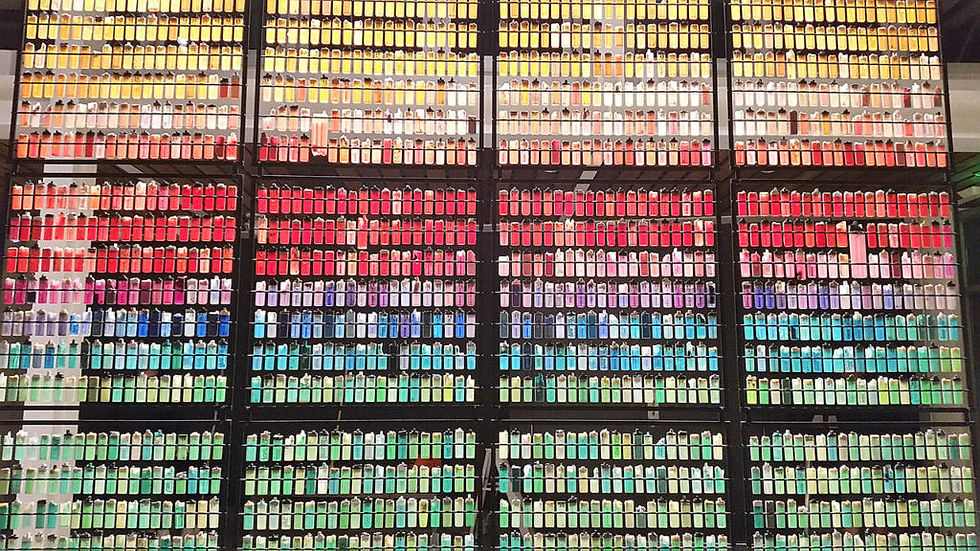
April Surgent’s “All the little things: Portrait of an Ocean, 2017”. The colorful 9-foot-by-9-foot grid shows hundreds of disposable lighters that were found by Surgent and others on small atolls northwest of Hawaii. Surgent was there in 2017 as a resident artist and volunteer with the Hawaiian Monk Seal Research Program.

"My work is both a response to and an interpretation of the world, but it also imparts sentiment through projection that comes from a perspective of anxiety about the condition of landscape and nature in our world today." ~ Philip Govedare

"Ptolemy Elrington is an artist based in the coastal city of Brighton, and his sculptures explore the damage caused by unsustainable resources. In using found objects from manufactured products, such as shopping trolleys or car hub caps, Erlington opens up a vital dialogue about the impact of waste on our environment." (Artsper Magazine, 10 Artists Working in Recycled Art)

“The coral reef is a microcosm of a macrocosm,” says paper artist Rogan Brown. “What is happening to the reefs today will ultimately happen to the planet tomorrow unless action is taken.” Through new paper sculptures comprised of delicately fringed sea creatures, Brown (previously) creates a striking visual display of the disastrous impacts of the climate crisis on marine life, showing how issues like coral bleaching can radiate outward into the wider world. (This is Colossal: Exquisitely Cut Paper Sculptures by Rogan Brown...)
In her ongoing project Interwoven 2015 – , Diana Scherer focuses on the dynamics of underground plant parts. The root system, with its hidden, subterranean life, is considered by plant neurobiologists to be the plant’s brain. In this project, the artist brings to light subterranean processes. Scherer employs a unique technique that uses the natural growth processes to create various structures out of root tissues.
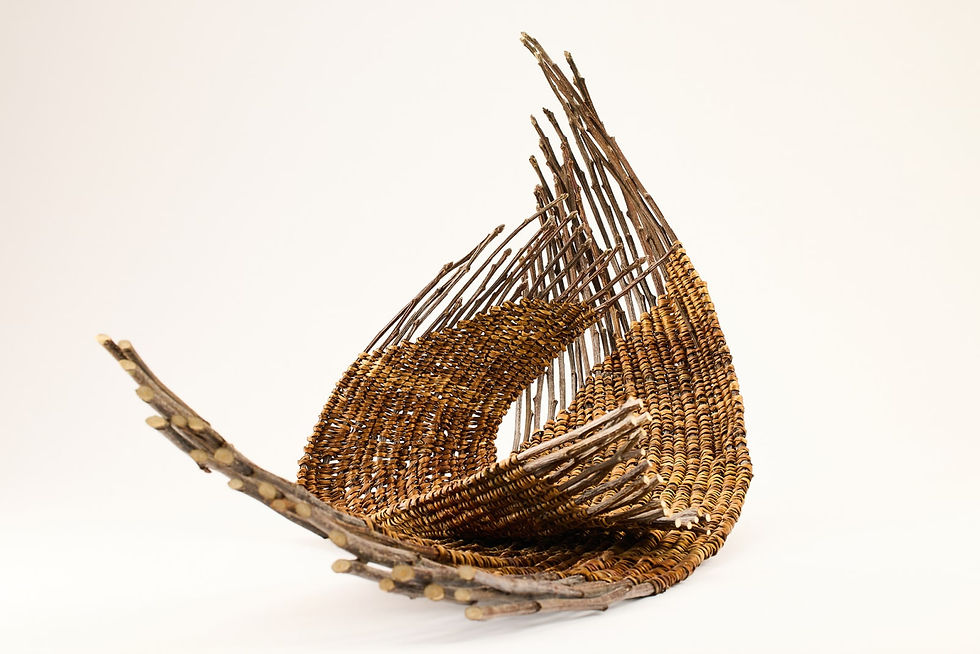
Sustainability is at the heart of Alice Fox’s practice. The desire to take an ethical approach has driven a shift from using conventional art and textile materials into exploring found objects, gathered materials and natural processes. She gathers the materials that are available to her; testing, sampling and exploring them to find possibilities using her textiles-based skill set and techniques borrowed from soft basketry. (jaggedart, Alice Fox)
I feel I should apologize for the considerable length of this post, but believe me, people, these amazing artists are only a fraction of the tip of the iceberg. As concerns about global climate change and its affects ramp up, more and more artists are finding ways to express their growing sense of alarm. So, I will be sharing the work of more ecoartists in the future.
I have recently been accepted into an organization called ecoartspace. I'm honored to be included in this group of widely-varied eco-artists whose work is both truly inspirational and powerful. Be sure to check their work out here.
One more little piece from me:
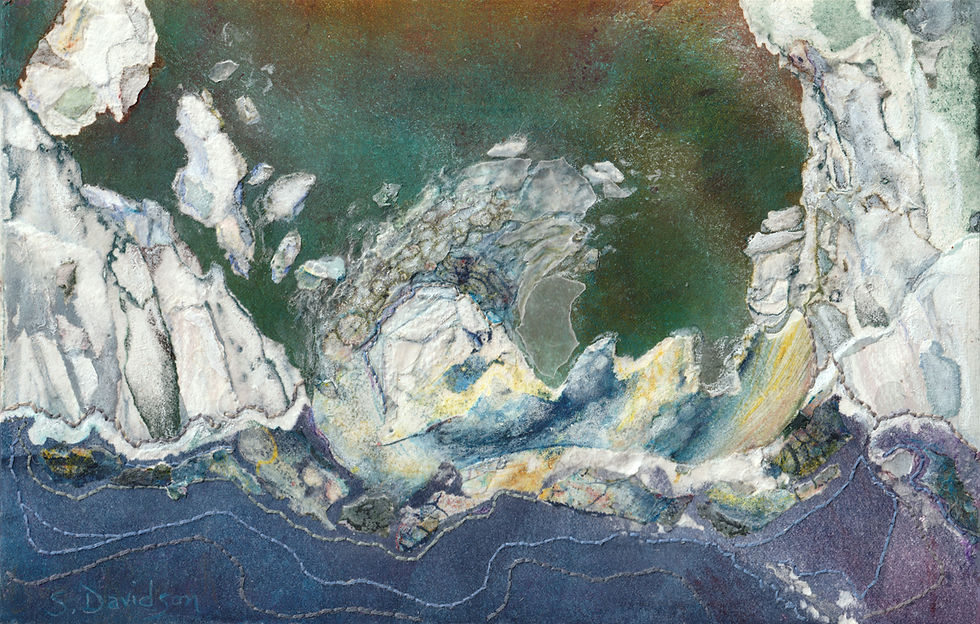
Bibliography/ Further Reading
Artsper Magazine, Art and Nature: The Emergence of Ecological Art, Dominic Witec
Artterra, The Complete Guide to Eco-Art and Environmental Art: Connecting Art and Nature for a Sustainable Future
Art, Education, and Environment Blog, Hilary Inwood .CA
1st Art Gallery, Visionary Eco-Artists: Inspiring Change Through Art and Ecology, Ethan Garcia
What is Eco-art? Being More Purposeful in Your Expression, Amber Merton
*Other links are in the text.



















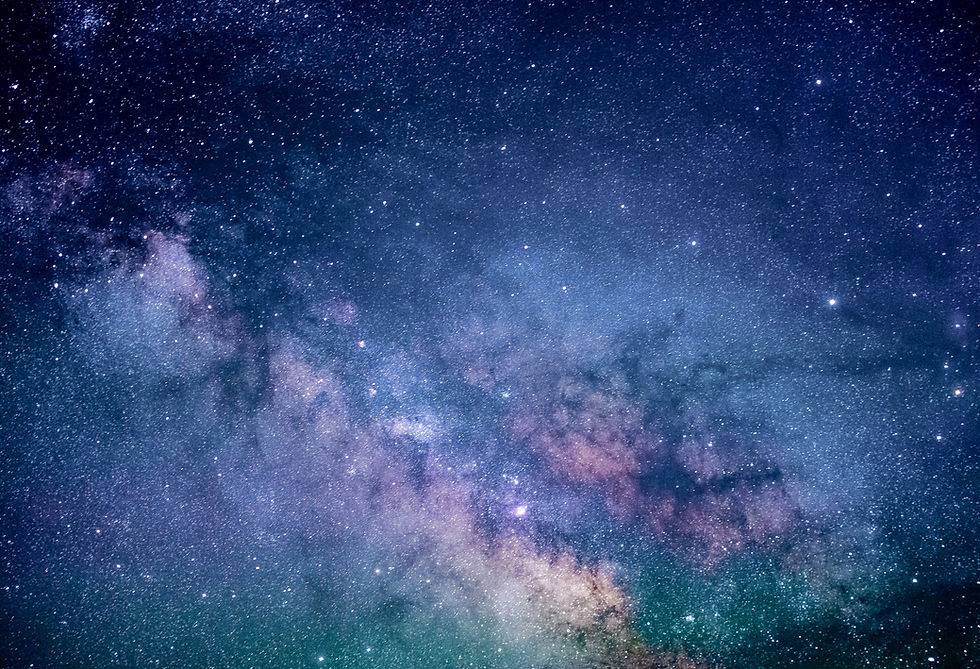
Comments